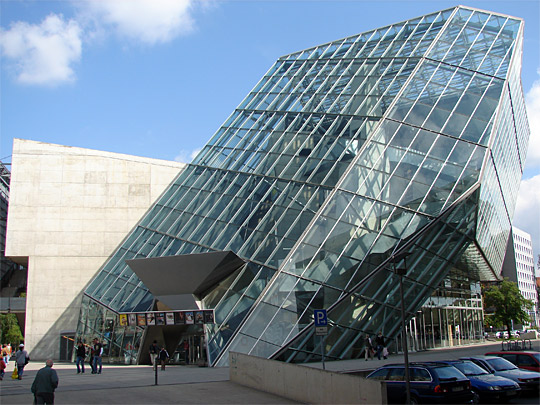Deconstructivism
Deconstructivism is a Postmodern architectural style characterised by the idea of fragmentation and the manipulation of a structure’s surface. Buildings adopting the style are often formed of components that have been disassembled and reassembled in a new and unorthodox way, giving the impression of a chaotic design devoid of precise logic.
It attempts to move away from the conventions of modernism that can be viewed as ‘constricting rules’, such as the notions that ‘form follows function’, ‘purity of form’, and ‘truth to materials’.
Deconstructivism in architecture was influenced by the deconstructivist theories of the French philosopher Jacques Derrida, who said that ‘architecture is nothing but one of many ways of communication’. It was also influenced by early-20th century constructivist architecture developed in Soviet Russia.
Deconstructivism developed out of the postmodern style and first gained widespread attention in 1988 with an exhibition entitled ‘Deconstructivist Architecture’ in New York’s Museum of Modern Art. The exhibition featured the work of architects such as Frank Gehry, Rem Koolhaas and Zaha Hadid. Where deconstructivism deviates from the postmodernist style in its rejection of ornament as decoration.
Other defining stylistic features include:
- Unrelated forms.
- Abstract nature.
- Smooth exterior surfaces.
- Contrast of shapes and forms.
- Large expanses of a single material (glass, metals, masonry, etc.).
- Window frames often hidden in the walls.
- Simple metal frame doors.
- Exposed materials.
The rise in prominence of computer-aided design (CAD) in contemporary architecture was a key factor in the development of deconstructivism, as three-dimensional modeling enabled the intricate design of complicated and unorthodox shapes and spaces.
Despite seeking to distance himself from the label, one of the most prominent architects associated with the style is Frank Gehry, whose Santa Monica residence – the building for which he first received critical acclaim – is regarded as the prototypical deconstructivist building, as well as his later buildings the Guggenheim Museum and Walt Disney Concert Hall.
Other architects who have been identified with the style are Zaha Hadid, Peter Eisenman, Rem Koolhaas, and Daniel Libeskind.
The most notable examples of deconstructivism are:
- CCTV Headquarters, Beijing.
- Dancing House, Prague.
- Imperial War Museum, Manchester.
- Guggenheim Museum, Bilbao.
- Jewish Museum, Berlin.
- Walt Disney Concert Hall, Los Angeles.
[edit] Related articles on Designing Buildings Wiki
- Architectural styles.
- Art Deco.
- Art Moderne.
- Art Nouveau.
- Bauhaus.
- BEST Products showrooms.
- Blobitecture.
- Brutalism.
- Chinese brutalism.
- Computer aided design (CAD).
- Concept architectural design.
- Constructivist architecture.
- Dancing House, Prague.
- Frank Gehry.
- Guggenheim Museum, Bilbao.
- High-tech architecture.
- Italian brutalism.
- Metabolism.
- Peter Eisenman.
- Parametricism.
- Postmodern architecture.
- Spomeniks.
- Walt Disney Concert Hall.
- Zaha Hadid.
[edit] External references
Featured articles and news
RTPI leader to become new CIOB Chief Executive Officer
Dr Victoria Hills MRTPI, FICE to take over after Caroline Gumble’s departure.
Social and affordable housing, a long term plan for delivery
The “Delivering a Decade of Renewal for Social and Affordable Housing” strategy sets out future path.
A change to adoptive architecture
Effects of global weather warming on architectural detailing, material choice and human interaction.
The proposed publicly owned and backed subsidiary of Homes England, to facilitate new homes.
How big is the problem and what can we do to mitigate the effects?
Overheating guidance and tools for building designers
A number of cool guides to help with the heat.
The UK's Modern Industrial Strategy: A 10 year plan
Previous consultation criticism, current key elements and general support with some persisting reservations.
Building Safety Regulator reforms
New roles, new staff and a new fast track service pave the way for a single construction regulator.
Architectural Technologist CPDs and Communications
CIAT CPD… and how you can do it!
Cooling centres and cool spaces
Managing extreme heat in cities by directing the public to places for heat stress relief and water sources.
Winter gardens: A brief history and warm variations
Extending the season with glass in different forms and terms.
Restoring Great Yarmouth's Winter Gardens
Transforming one of the least sustainable constructions imaginable.
Construction Skills Mission Board launch sector drive
Newly formed government and industry collaboration set strategy for recruiting an additional 100,000 construction workers a year.
New Architects Code comes into effect in September 2025
ARB Architects Code of Conduct and Practice available with ongoing consultation regarding guidance.
Welsh Skills Body (Medr) launches ambitious plan
The new skills body brings together funding and regulation of tertiary education and research for the devolved nation.
Paul Gandy FCIOB announced as next CIOB President
Former Tilbury Douglas CEO takes helm.
UK Infrastructure: A 10 Year Strategy. In brief with reactions
With the National Infrastructure and Service Transformation Authority (NISTA).























